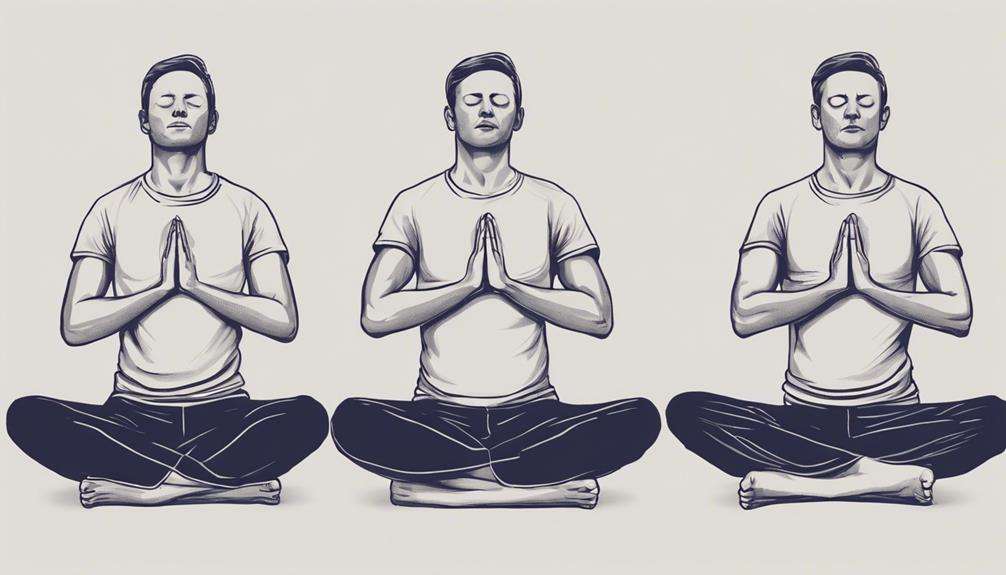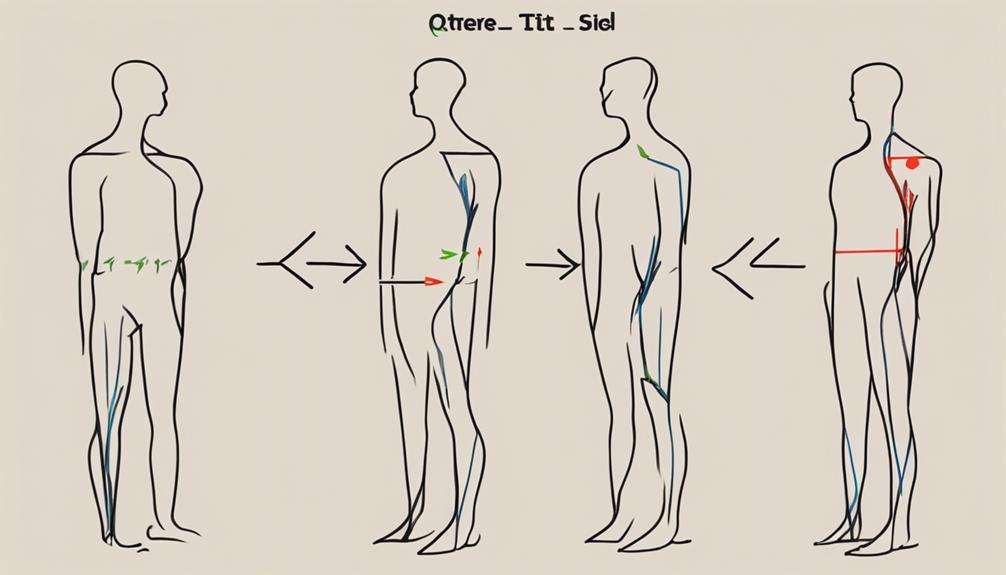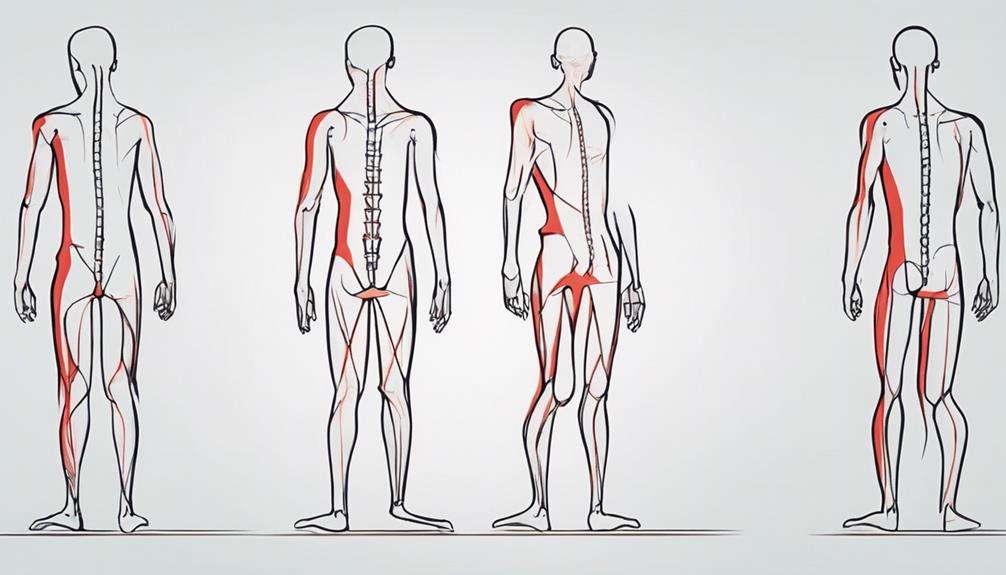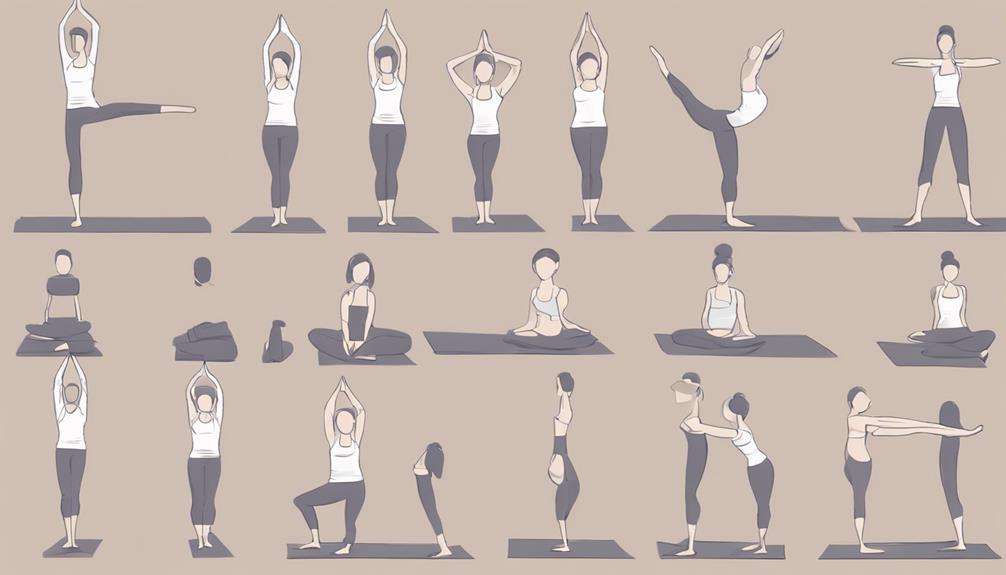When your back feels like a tightly wound spring, relief can seem out of reach. But did you know that with the right yoga techniques, you can unravel that tension naturally?
By exploring the gentle movements and mindful breathing of specific poses, you may discover a path to easing your back discomfort without relying on medication or invasive procedures.
So, how exactly can these ancient practices soothe your aching back?
Key Takeaways
- Yoga improves posture and spine alignment, reducing back muscle strain.
- Core engagement in yoga strengthens spinal support and prevents back pressure.
- Mind-body techniques like deep breathing and meditation alleviate chronic back pain.
- Incorporating specific yoga poses and lifestyle changes can naturally relieve back pain.
Benefits of Improved Posture
Improving your posture through yoga can greatly reduce strain on your back muscles and spine, leading to a decreased risk of back pain. By focusing on techniques that enhance posture, yoga promotes proper alignment of the vertebrae, which is essential for maintaining spine health.
Strengthening core muscles is a key aspect of yoga practice, since these muscles provide vital support for a healthy posture. Additionally, practicing yoga regularly can help increase body awareness and mindfulness, allowing you to maintain good posture not only during yoga sessions but also throughout your daily activities.
This increased awareness can lead to tension relief in areas such as the neck, shoulders, and lower back, which are commonly affected by poor posture. Incorporating yoga into your routine can't only improve your posture but also contribute to overall spine health and reduce the risk of back pain in the long run.
Alignment Techniques for Back Pain
Enhancing alignment in yoga poses is instrumental in relieving back pain, as it reduces strain on the spine and supports proper posture. Alignment techniques play a vital role in maintaining a neutral spine, engaging core muscles, and distributing weight evenly, all of which are essential in preventing back discomfort.
By focusing on mindful alignment during yoga practice, individuals can alleviate pressure on the lower back, promoting spinal health and reducing the risk of injury. Proper alignment not only helps in reducing strain but also leads to improved balance, stability, and decreased tension in the back muscles.
Learning and implementing alignment techniques in yoga can have long-term benefits, including increased flexibility, strength, and overall back health. By prioritizing alignment and posture in your yoga practice, you can effectively manage back pain, enhance spinal health, and experience greater comfort and well-being.
Strengthening Core for Better Support

Strengthening your core muscles through specific yoga poses like Plank and Boat can greatly enhance spinal support and alleviate back pain. Core strength plays an important role in reducing back pain by improving posture, which helps maintain proper spinal alignment and reduces pressure on the back.
Engaging the core in poses such as Chair Pose and Warrior III enhances stability, preventing strain on the lower back muscles. Yoga techniques that target the core, like Side Plank and Bird Dog, contribute to overall spinal health and decrease the likelihood of back injuries.
Mind-Body Connection for Pain Relief
When it comes to managing back pain through yoga, focusing on the mind-body connection is key.
Practices like deep breathing and mindfulness can help alleviate stress, leading to relaxation and pain relief.
Research supports the notion that incorporating these techniques into your yoga routine can enhance overall well-being and reduce the intensity of chronic back pain.
Breath and Relaxation
Utilizing deep breathing techniques in yoga can effectively reduce stress and tension in the body, leading to natural alleviation of back pain. Mindful relaxation practices, such as progressive muscle relaxation and guided imagery, enhance the mind-body connection, promoting pain relief.
Yoga triggers the release of endorphins, natural hormones that help manage back pain. Integrating meditation and mindfulness into yoga sessions enhances relaxation, reduces muscle tension, and eases back discomfort.
Meditation for Healing
Deepening your understanding of the mind-body connection through meditation can greatly enhance your ability to manage and alleviate back pain.
Meditation has been proven to reduce the perception of pain by altering brain activity and inducing relaxation.
Mindfulness meditation techniques can assist individuals in managing chronic pain by increasing pain tolerance and reducing emotional distress.
Integrating meditation into your daily routine can result in long-term pain relief and an overall improved quality of life.
Practices like focused breathing and body scan techniques can strengthen the mind-body connection for effective pain management.
Studies suggest that regular meditation can modulate pain pathways in the brain, providing a natural approach to alleviating back pain.
Relaxation Techniques to Reduce Tension

To reduce tension in your back muscles, consider incorporating relaxation techniques such as deep breathing and progressive muscle relaxation. Deep breathing exercises help calm the mind and relax the body, reducing stress and tension in the back muscles. Progressive muscle relaxation involves tensing and then releasing different muscle groups, promoting awareness of muscle tension and encouraging relaxation. Additionally, mindfulness meditation and guided imagery can aid in reducing stress, which may alleviate back pain naturally by promoting relaxation.
Incorporating gentle stretching exercises like gentle twists and side bends can also help release tightness in the back, providing relief from discomfort. Restorative yoga poses such as legs up the wall or reclining bound angle pose can further relax the back muscles and promote healing. By practicing mindfulness in daily activities, maintaining good posture, and taking breaks to stretch, you can prevent back pain and enhance overall well-being. These relaxation techniques can be valuable tools in managing and reducing back pain.
Breathing Exercises for Back Pain
To address back pain effectively, consider integrating breathing exercises that target muscle tension and promote relaxation in the affected area. Deep diaphragmatic breathing can help reduce stress and tension in the back muscles, leading to relaxation and pain relief. Incorporating breath awareness in yoga poses enhances spinal mobility and improves circulation, supporting overall back health. Techniques like the 'Three-Part Breath' or 'Sama Vritti' can calm the nervous system, decreasing the perception of pain in the back.
Proper breathing techniques during yoga engage the core muscles, providing stability and support for the spine. Consistent practice of breathing exercises increases oxygen flow to the back muscles, aiding in healing and recovery from back pain. By focusing on your breath and incorporating these exercises into your routine, you can alleviate back pain naturally and improve your overall well-being. Remember, the power of breath can be a potent tool in your journey towards a healthier back.
Developing a Consistent Yoga Practice

Consistently practicing yoga is key to effectively managing and reducing back pain naturally. Regular yoga sessions play an important role in strengthening core muscles that support the spine, hence alleviating back discomfort.
By developing a routine that includes specific poses such as Cat-Cow, Child's Pose, and Cobra Pose, individuals can experience significant benefits in managing back pain. These poses not only help in stretching and strengthening the back muscles but also contribute to overall spinal health.
Yoga techniques focus on improving flexibility, enhancing posture, and promoting a healthy spine, all of which are essential for reducing back pain. A mindful and consistent yoga practice can lead to long-term relief from back pain without the need for medication.
Therefore, incorporating yoga into your daily routine can be highly beneficial for those looking to alleviate and prevent back pain naturally.
Frequently Asked Questions
What Type of Yoga Is Best for Back Pain?
For back pain relief, consider gentle stretches, restorative poses, alignment focus, core strength, mind-body connection, breath awareness, and flexibility training. These practices in yoga can help alleviate discomfort and promote overall well-being.
Which Asana Gives Instant Relief From Back Pain?
For instant relief from back pain, try Cat-Cow to improve spinal flexibility and Cobra to strengthen your spine. Incorporating these asanas into your practice can help alleviate discomfort and promote overall back health naturally.
Can Yoga Help All Sorts of Back Pain?
Yoga can effectively address various back pain types by enhancing your mind-body connection, teaching breathing techniques, improving core strength, providing flexibility benefits, reducing stress, enhancing alignment awareness, and aiding in posture improvement.
How Long Does Yoga Take to Fix Back Pain?
In your journey to alleviate back pain through yoga, understand that the time commitment varies. Consistent practice, patience, and gradual progress are key. Individual results may differ, but long-term benefits await those who persist in the healing process.
Conclusion
To sum up, incorporating beginner-friendly yoga poses like Cat-Cow, Cobra, and Child's Pose into your routine can naturally relieve back pain and improve overall well-being.
Just like a gentle breeze on a hot day, these techniques can help ease tension, strengthen muscles, and promote relaxation for a healthier spine.
Remember to listen to your body, consult a healthcare professional if needed, and enjoy the benefits of a consistent yoga practice.






